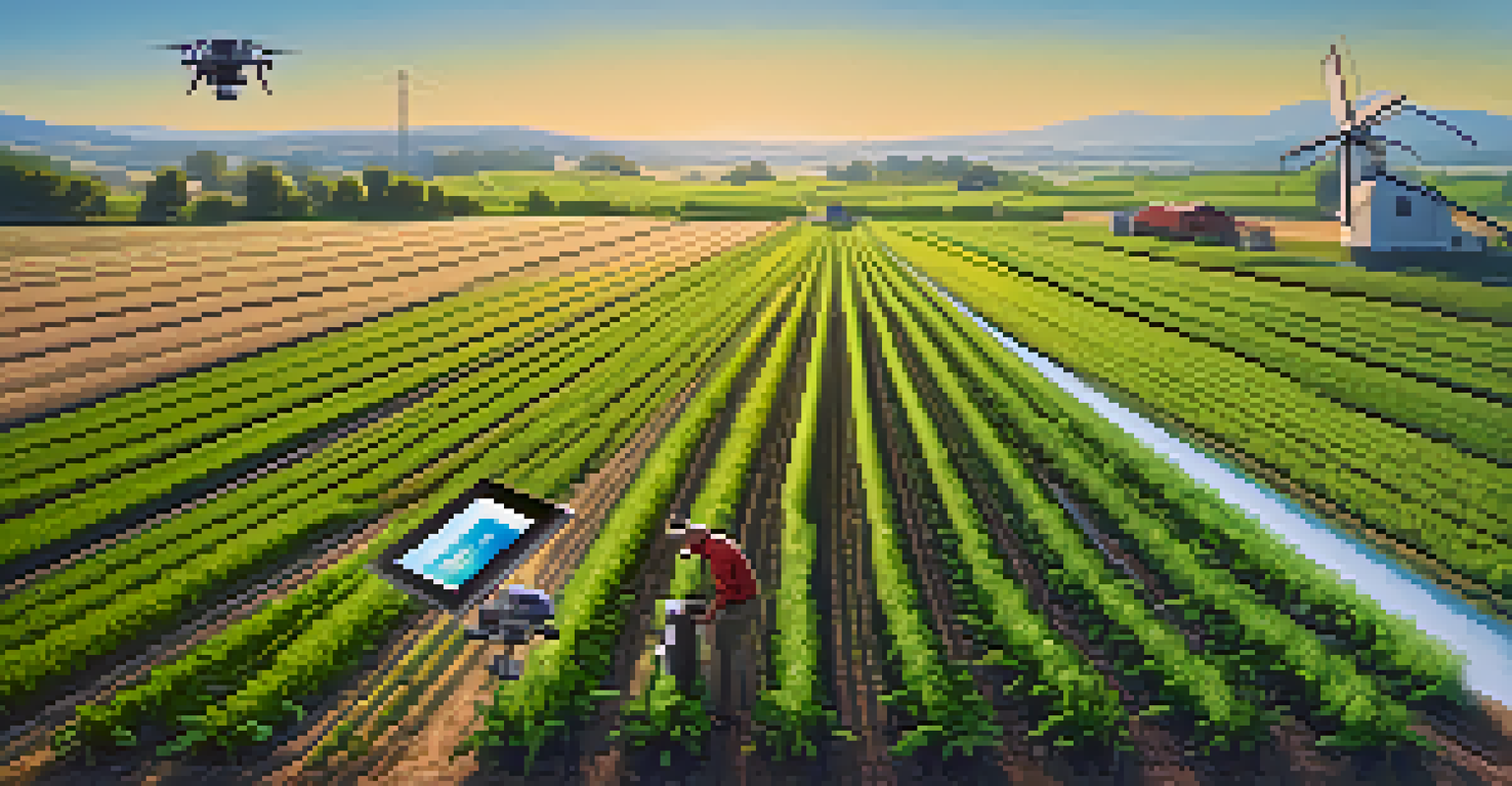Edge AI in Agriculture: Smart Farming Techniques

Understanding Edge AI and Its Role in Agriculture
Edge AI refers to artificial intelligence that processes data locally on devices rather than relying on centralized cloud systems. This means that farms can analyze data in real-time, leading to faster decision-making. For instance, sensors in the field can detect moisture levels and adjust irrigation systems without waiting for data to be sent to a distant server.
The future of agriculture is not in more land, but in more information.
The ability to make quick decisions is crucial in agriculture, where conditions can change rapidly due to weather or pest outbreaks. By leveraging Edge AI, farmers can respond to these changes immediately, optimizing resources and minimizing losses. This technology empowers farmers with actionable insights right at the source.
In summary, Edge AI acts as a game-changer in agriculture, allowing for smarter and more efficient farming practices. It enables farmers to harness real-time data to enhance productivity and sustainability.
Key Smart Farming Techniques Using Edge AI
One prominent technique is precision agriculture, where Edge AI helps in monitoring crop health and soil conditions. For example, drones equipped with AI can fly over fields to assess plant growth and identify areas needing attention. This targeted approach reduces waste and improves yield.

Another technique is automated irrigation systems, which use data from soil moisture sensors to determine when and how much water to dispense. By utilizing Edge AI, these systems can operate independently, ensuring that crops receive the right amount of water at the right time, thus conserving water resources.
Edge AI Enhances Farming Efficiency
By processing data locally, Edge AI allows farmers to make real-time decisions, optimizing resources and improving productivity.
Overall, these smart farming techniques not only enhance efficiency but also contribute to sustainable farming practices. By minimizing inputs while maximizing outputs, farmers can achieve better results with less environmental impact.
Benefits of Edge AI in Smart Farming
The primary benefit of Edge AI in agriculture is increased efficiency. By analyzing data on-site, farmers can save time and resources, leading to higher productivity. For instance, farmers can quickly identify pest infestations and take action before they spread, ensuring crops remain healthy.
Technology is best when it brings people together.
Additionally, Edge AI contributes to better decision-making by providing farmers with real-time insights. For example, farmers can adjust their planting schedules based on immediate weather conditions, optimizing their operations. This agility is essential in a field where timing can significantly impact yields.
Moreover, the use of Edge AI can lead to significant cost savings over time. By optimizing resource usage and reducing waste, farmers can lower their operational costs while increasing profitability, creating a win-win situation.
Challenges Faced by Farmers Implementing Edge AI
Despite its advantages, adopting Edge AI in agriculture is not without challenges. One significant hurdle is the initial investment required for technology and infrastructure. Farmers may hesitate to adopt new systems without clear evidence of return on investment.
Another challenge is the need for technical expertise to operate and maintain Edge AI systems. Many farmers may not have the necessary training, which can lead to underutilization of the technology. This gap highlights the importance of education and support in the industry.
Smart Techniques for Sustainable Farming
Techniques like precision agriculture and automated irrigation driven by Edge AI help reduce waste and maximize yields.
Lastly, data privacy and security concerns can deter farmers from embracing Edge AI. Ensuring that sensitive information is protected is vital for building trust and encouraging adoption. Addressing these challenges is crucial for the successful integration of Edge AI in agriculture.
The Future of Edge AI in Agriculture
The future of Edge AI in agriculture looks promising, with continuous advancements in technology. As hardware becomes more affordable and user-friendly, more farmers are likely to adopt these smart solutions. This trend could lead to widespread transformations in farming practices.
Moreover, the integration of Edge AI with other technologies, such as IoT (Internet of Things), will further enhance precision farming. For instance, interconnected devices can seamlessly share data, creating a comprehensive farming ecosystem that maximizes efficiency and productivity.
As we move forward, collaboration among tech companies, agricultural experts, and farmers will be essential. By working together, they can develop tailored solutions that meet the unique needs of the agricultural sector, ensuring a sustainable and productive future.
Real-World Examples of Edge AI in Farming
Several farms worldwide are already reaping the benefits of Edge AI technology. For example, a vineyard in California uses AI-driven sensors to monitor grape ripeness, allowing for precise harvesting times. This not only improves the quality of the wine but also maximizes yield.
Another example can be seen in livestock farming, where farmers use Edge AI to monitor animal health and behavior. Wearable devices track vital signs and movement patterns, alerting farmers to potential issues before they become serious, thus ensuring better animal welfare.
Challenges in Adopting Edge AI
Farmers face hurdles such as initial investment costs, technical expertise requirements, and data privacy concerns when implementing Edge AI.
These case studies illustrate how Edge AI is being applied in real-world scenarios, showcasing its potential to revolutionize the agricultural landscape. As more farmers share their success stories, the adoption of this technology is likely to grow.
Conclusion: Embracing Edge AI for Sustainable Agriculture
In conclusion, Edge AI presents a transformative opportunity for agriculture, enabling smart farming techniques that enhance efficiency and sustainability. By utilizing real-time data, farmers can make informed decisions that lead to better resource management and increased productivity.
As challenges are addressed and technology becomes more accessible, the agricultural sector can expect to see significant advancements. Embracing Edge AI not only benefits individual farmers but also contributes to global food security and environmental sustainability.

Ultimately, the integration of Edge AI in agriculture is not just about technology—it's about empowering farmers to create a more sustainable future for all. As we look ahead, the collaboration between technology and agriculture will be key to unlocking this potential.